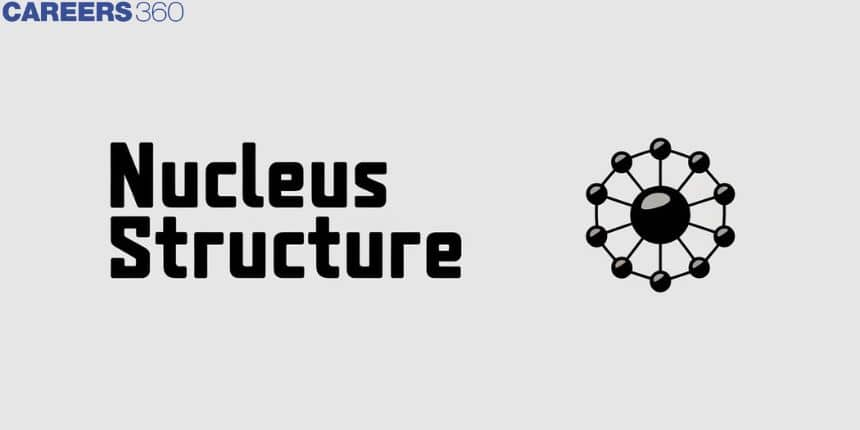Nucleus Structure
The structure of the nucleus, the central core of an atom, is fundamental to understanding the nature of matter and the forces that govern atomic interactions. Comprising protons and neutrons bound together by the strong nuclear force, the nucleus determines the identity and stability of elements. This knowledge is pivotal in numerous real-life applications, from the generation of energy in nuclear reactors to the development of medical treatments such as radiotherapy. By studying the nucleus, scientists can also explore the origins of elements in stars and the mechanisms of nuclear fusion and fission, which have both profound scientific and practical implications. In this article, we will discuss the concept of Nucleus Structure in detail and provide examples for better understanding.
This Story also Contains
- Nucleus Structure
- Different Types of Nuclei
- Recommended Topic Video
- Solved Examples Based on Nucleus Structure
- Summary

Nucleus Structure
The structure of the nucleus, the central core of an atom, is fundamental to understanding the nature of matter and the forces that govern atomic interactions. Composed of protons and neutrons held together by the strong nuclear force, the nucleus determines the identity and stability of elements.
What is an atom?
An atom is the smallest unit of matter that retains the properties of an element. It consists of a central nucleus, which contains positively charged protons and neutral neutrons, surrounded by a cloud of negatively charged electrons. These electrons occupy specific energy levels or orbitals around the nucleus.
What is a nucleus?
The nucleus is the dense, central core of an atom, composed of protons and neutrons, collectively known as nucleons. It contains nearly all of the atom's mass and is held together by the strong nuclear force, one of the four fundamental forces of nature. The atom consists of a central core called ‘nucleus’ and the electrons revolve around it in nearly circular orbits as shown in the below figure.

The nucleus of an atom consists of neutrons and protons, collectively referred to as nucleons. The neutron carries no electrical charge and has a mass slightly larger than that of a proton.
Constituents of the nucleus (Nucleons)
(a) Protons:-
Mass of proton,
Charge of proton
(b) Neutron:-
Mass of neutron,
The proton is the main part of an atom and carries a positive charge. The number of protons and neutrons is usually the same except in the case of the hydrogen atom which contains a single proton that exists on its own.
The number of protons in a nucleus (called the atomic number or proton number) is represented by the symbol Z.
The number of neutrons (neutron number) is represented by N.
The total number of neutrons and protons in a nucleus is called its mass number and it is represented by N.
And we have A= Z+ N.
Different Types of Nuclei
- Isotopes- The atoms of an element having the same atomic number but different mass numbers arecalled isotopes. All isotopes have the same chemical properties.
The isotopes of some elements are the following
Isobars: The nuclei which have the same mass number (A) but a different atomic number (Z) are called isobars. Isobars occupy different positions in the periodic table so all isobars have different chemical properties.
Some of the examples of isobars are
Isotones: The nuclei having an equal number of neutrons are called isotones. For them both the atomic number (Z) and mass number (A) are different, but the value of (N=A–Z) is the same.
Some examples of Isotones are the following
Size of the Nucleus
- Nuclear radius - The radius r of the nucleus depends upon the atomic mass A of the element
Nuclear volume: The volume of the nucleus is given by
Nuclear density: The mass per unit volume of a nucleus is called nuclear density. It is given as
Density is constant for all the nuclei. It is independent of size and mass numbers.
Recommended Topic Video
Solved Examples Based on Nucleus Structure
Example 1: A certain mass of hydrogen is changed to He by the process of fusion. The mass defect in the fusion reaction is 0.02866
1) 6.675
2) 26.7
3) 2.67
4) 13.35
Solution:
Mass of electron, proton & neutron in terms of energy
As
Here,
Hence, the answer is the option (1).
Example 2: If radius of the
1)
2)
3)
4)
Solution:
The radius of the nucleus is given by
Hence, the answer is the option (2)
1) 1
2) 0.1
3) 5
4) 2
Solution:
The ratio of mass densities of Nuclei of
Hence, the answer is the option (1).
Example 4: Density of which of the following nuclei is highest
1) Hydrogen
2) Iron
3) Uranium
4) All have the same densities
Solution:
Density is constant for all the nuclei. It is independent of size and mass number.
Since nuclear density is independent of mass number and hence all the nuclei have the same densities.
Hence, the answer is the option (4).
Example 5: The radius
1)
2)
3)
4)
Solution:
Hence, the answer is the option (4).
Summary
The nucleus, the central core of an atom, is composed of protons and neutrons, collectively known as nucleons. It determines the identity and stability of elements, with their size influencing various nuclear properties such as volume and density. Despite differences in size, the density of all nuclei remains constant. Understanding the nucleus's structure is essential for numerous real-life applications, including nuclear energy generation and medical treatments like radiotherapy. Through examples, the concepts of nuclear radius, volume, and density are illustrated, showcasing the nucleus's fundamental role in atomic and nuclear physics.